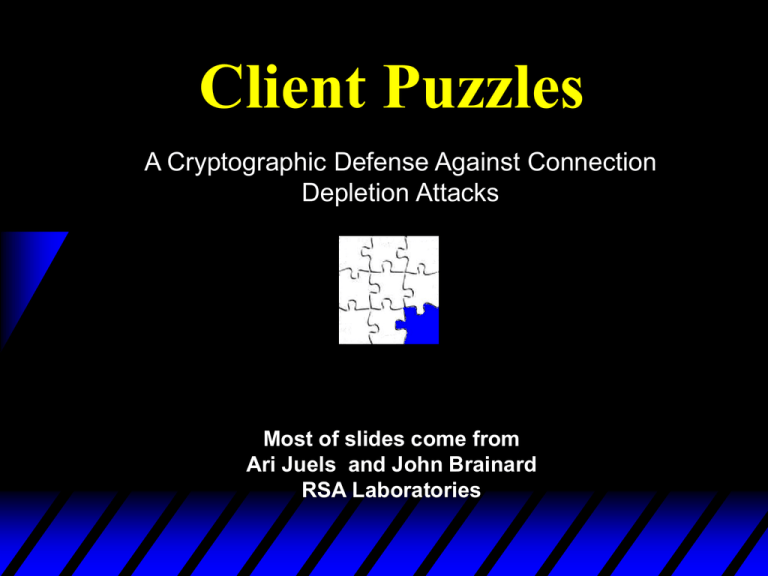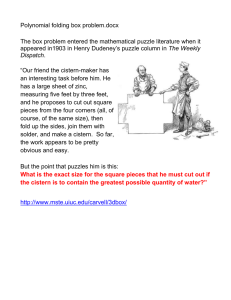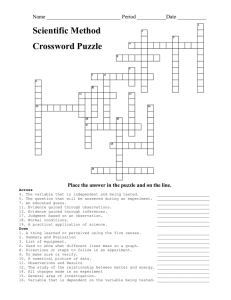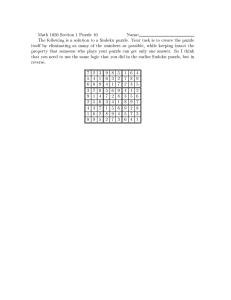Client Puzzles A Cryptographic Defense Against Connection Depletion Attacks
advertisement

Client Puzzles A Cryptographic Defense Against Connection Depletion Attacks Most of slides come from Ari Juels and John Brainard RSA Laboratories The Problem How to take down a restaurant Restauranteur Saboteur Table for four at 8 o’clock. Name of Mr. Smith. O.K., Mr. Smith Restauranteur Saboteur Saboteur vs. Restauranteur Restauranteur Saboteur No More Tables! An example: TCP SYN flooding “TCP “TCPconnection, connection,please.” please.” “O.K.Please Pleasesend sendack.” ack.” “O.K. Buffer TCP SYN flooding has been deployed in the real world – Panix, mid-Sept. 1996 – New York Times, late Sept. 1996 – Others Similar attacks may be mounted against e-mail, SSL, etc. Some defenses against connection depletion Throw away requests Server Client “Hello?” Buffer Problem: Legitimate clients must keep retrying IP Tracing (or Syncookies) Client Server Hi. My name is Request 10.100.16.126. Buffer Problems: •Can be evaded, particularly on, e.g., Ethernet •Does not allow for proxies, anonymity Digital signatures Client Server Buffer Problems: •Requires carefully regulated PKI •Does not allow for anonymity Connection timeout Server Client Problem: Hard to achieve balance between security and latency demands Our solution: client puzzles Intuition ??? Table for four at 8 o’clock. Name of Mr. Smith. Please solve this puzzle. O.K.,O.K. Mr. Smith Restauranteur Intuition Suppose: A puzzle takes an hour to solve There are 40 tables in restaurant Reserve at most one day in advance A legitimate patron can easily reserve a table Intuition ??? ??? ??? ??? ??? ??? Would-be saboteur has too many puzzles to solve The client puzzle protocol Client Service request M Server Buffer O.K. What does a puzzle look like? Puzzle basis: partial hash inversion ? X’ X ? pre-image partial-image k bits 160 bits hash image Y Pair (X’, Y) is k-bit-hard puzzle Puzzle basis: (Cont’d) way to solve puzzle (X’,Y) is brute force method. (hash function is not invertible) Expected number of steps (hash) to solve puzzle: 2k / 2 = 2k-1 Only Puzzle construction Client Server Service request M Secret S Puzzle construction Server computes: secret S time T request hash pre-image hash image Y M Puzzle X Sub-puzzle S 1 hash T 2 hash M m hash X[1] X[2] X[m] hash hash hash Y[1] Y[2] Y[m] Construct a puzzle consists of m k-bit-hard subpuzzles. Increase the difficulty of guessing attacks. Expected number of steps to solve: m×2k-1. Puzzle properties Puzzles are stateless Puzzles are easy to verify Hardness of puzzles can be carefully controlled Puzzles use standard cryptographic primitives Client puzzle protocol (normal) Mi1 : first message of ith execution of protocol M Client puzzle protocol (under attack) P: puzzle with m sub-puzzles t: timestamp of puzzle τ: time to receive solution T1: valid time of puzzle Where to use client puzzles? Some pros Avoids many flaws in other solutions, e.g.: Allows for anonymous connections Does not require PKI Does not require retries -- even under heavy attack Practical application Can use client-puzzles without specialpurpose software – Key idea: Applet carries puzzle + puzzlesolving code Where can we apply this? – SSL (Secure Sockets Layer) – Web-based password authentication Conclusions Contributions of paper Introduces idea of client puzzles for onthe-fly resource access control Puzzle and protocol description Rigorous mathematical treatment of security using puzzles -probabilistic/guessing attack Questions?



